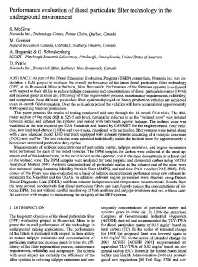Mining Publication: Performance Evaluation of Diesel Particulate Filter Technology in the Underground Environment
Original creation date: October 2002
As part of the Diesel Emissions Evaluation Program (DEEP) consortium, Noranda Inc. has undertaken a field project to evaluate the overall performance of the latest diesel particulate filter technology (DPF) at its Brunswick Mine in Bathurst, New Brunswick. Performance of the filtration systems is evaluated with respect to their ability to reduce tailpipe emissions and concentrations of diesel particulate matter (DPM) and noxious gases in mine air, efficiency of filter regeneration process, maintenance requirements, reliability, and acceptance. Four different particulate filter systems deployed on heavy production vehicles are subjected to an 18-month field evaluation. Over the evaluation period the vehicles will have accumulated approximately 4000 operating hours in production.
This paper presents the results of testing conducted mid way through the 18-month field trials. The 400meter section of the mine drift at 525-5 sub level, hereinafter referred to as the "isolated zone" was isolated between intake and exhaust fan systems and sealed with bulkheads against leakage. The isolated zone was ventilated at the rate required per CSA Standards and issued by CANMET for the engines tested. Four vehicles, two load-haul-dumps (LHDs) and two trucks, retrofitted with particulate filter systems were tested along with a new identical model LHD and truck equipped with exhaust systems consisting of a catalytic converter (DOC) and muffler. The test vehicles were operated individually inside the isolated zone for approximately 4 hours over simulated production duty cycles.
Measurements of ambient concentrations of particulate matter, tailpipe emissions, and engine parameters were performed for each of the tested vehicles. The DPM samples for carbon were collected at the most upstream end of the isolated zone, at the vehicle next to the operator, and at the most downstream or exhaust end of the isolated zone. The DPM samples were analyzed for total (organic and elemental) carbon using NIOSH Analytical Method 5040. Ambient concentrations of particulate matter at the exhaust end of the zone were also measured using Scanning Mobility Particle Sizer (SMPS), and real time PAH monitor (PAS 2000). Efficiency of the filters was also evaluated on a basis of tailpipe measurements performed using raw exhaust instruments the NanoMet and the UGAS. In addition, relevant engine parameters were obtained using Detroit Diesel Diagnostic Link (DDDL) and from exhaust backpressure and temperature measurements. Results from the tests proved conclusively that diesel particulate filters can significantly reduce the concentrations of airborne DPM, but not without careful monitoring of both ambient and tailpipe emissions and not without careful attention with respect to maintaining the integrity of the DPF systems.
Authors: S McGinn, M Grenier, AD Bugarski, GH Schnakenberg, D Petrie
Conference Paper - October 2002
NIOSHTIC2 Number: 20023131
Mine Ventilation. Lisse, Netherlands: A. A. Balkema, 2002 Oct; :433-440
See Also
- DEEP Project on Evaluation of Diesel Particulate Filters at Inco's Stobie Mine
- Diesel Exhaust Aerosol, Review of Measurement Technology
- Differential Pressure as a Measure of Particulate Matter Emissions from Diesel Engines
- Effects of Diesel Exhaust Aftertreatment Devices on Concentrations and Size Distribution of Aerosols in Underground Mine Air
- The Effects of Passive Diesel Particulate Filters on Diesel Particulate Matter Concentrations in Two Underground Metal/Nonmetal Mines
- Instrumentation for Diesel Particulate Matter Emissions Research
- Mutagenicity of Diesel Exhaust Particles from an Engine with Differing Exhaust After Treatments
- Real-Time DPM Ambient Monitoring in Underground Mines
- Role of Lubrication Oil in Particulate Emissions from a Hydrogen-Powered Internal Combustion Engine
- Sampling Results of the Improved SKC® Diesel Particulate Matter Cassette
- Page last reviewed: 9/21/2012
- Page last updated: 9/21/2012
- Content source: National Institute for Occupational Safety and Health, Mining Program


 ShareCompartir
ShareCompartir
